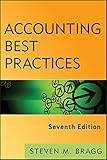Accounting best practices / Steven M. Bragg.
Material type: TextPublication details: Hoboken, N.J. : John Wiley & Sons, ©2013.Edition: 7th edDescription: 1 online resourceContent type:
TextPublication details: Hoboken, N.J. : John Wiley & Sons, ©2013.Edition: 7th edDescription: 1 online resourceContent type: - text
- computer
- online resource
- 9781118421833
- 1118421833
- 9781118417805
- 1118417801
- 9781118555958
- 1118555953
- 657 23
- HF5635
Includes index.
Print version record and CIP data provided by publisher.
Accounting Best Practices; Contents; Preface; Chapter 1: Overview of Best Practices; Chapter 2: How to Use Best Practices; Types of Best Practices; The Most Fertile Ground for Best Practices; Planning for Best Practices; Timing of Best Practices; Implementing Best Practices; Best Practice Duplication; Why Best Practices Fail; The Impact of Best Practices on Employees; Summary; Chapter 3: Accounts Payable Best Practices; Implementation Issues for Accounts Payable Best Practices; 3-1 Pay Based on Receiving Approval Only; 3-2 Reduce Required Approvals.
3-3 Use Negative Assurance for Invoice Approvals3-4 Designate Approval Stamp Positioning; 3-5 Base Approvals on Supplier Invoicing History; 3-6 Use Procurement Cards; 3-7 Use a Ghost Card; 3-8 Negotiate Procurement Card Rebates; 3-9 Route All Invoices Directly to Accounts Payable; 3-10 Split Payables Processing Based on Discounts; 3-11 Adopt a Standard Invoice Numbering Convention; 3-12 Automate Three-Way Matching; 3-13 Digitize Accounts Payable Documents; 3-14 Directly Enter Receipts into Computer; 3-15 Have Suppliers Include Their Supplier Number on Invoices.
3-16 Request that Suppliers Enter Invoices through a Web Site3-17 Audit Expense Reports; 3-18 Automate Expense Reporting; 3-19 Eliminate Cash Advances for Employee Travel; 3-20 Link Corporate Travel Policies to an Automated Expense Reporting System; 3-21 Match Travel Bookings to Expenses; 3-22 Centralize the Accounts Payable Function; 3-23 Store Late Fees in a Separate General Ledger Account; 3-24 Issue Standard Account Code List; 3-25 Link Supplier Requests to the Accounts Payable Database; 3-26 Shrink the Supplier Base; 3-27 Withhold First Payment until W-9 Form Is Received.
3-28 Automate Payments for Repetitive Invoicing3-29 Install a Payment Factory; 3-30 Eliminate Manual Checks; 3-31 Eliminate Wire Transfers; 3-32 Increase the Frequency of Check Runs; 3-33 Settle Foreign Intercompany Payables; 3-34 Have Regularly Scheduled Check-Signing Meetings; 3-35 Implement Positive Pay; 3-36 Incorporate Copy Protection Features into Checks; 3-37 Avoid Acronym Payees on Checks; 3-38 Revise Payment Terms for Electronic Payments; 3-39 Install Advanced ACH Debit Blocking; 3-40 Use a Signature Stamp; 3-41 Notify Purchasing of Lower Invoiced Prices or Terms.
3-42 Create Direct Purchase Interfaces to Suppliers3-43 Install a Low-Cost Spend Management System; 3-44 Use Blanket Purchase Orders; 3-45 Issue a Welcome Packet to New Suppliers; 3-46 Clean Up the Supplier Master File; 3-47 Adopt a Supplier Naming Procedure; 3-48 Assign Payables Staff to Specific Suppliers; 3-49 Create Different Supplier Accounts for Different Terms; 3-50 Review Supplier Statements for Open Credits; 3-51 Issue Standard Adjustment Letters to Suppliers; Summary; Chapter 4: Billing Best Practices; Implementation Issues for Billing Best Practices; 4-1 Avoid Missed Billings.
4-2 Remove Unnecessary Information from Invoices.
Praise for previous editions of Accounting Best Practices ""For a comprehensive, yet easy-to-read guide to fixing those all-too-common shortcomings in your accounting department, look no further than this excellent book. Steve Bragg provides hundreds of fixes, many of them requiring surprisingly little time or cost while providing a handy guide to common implementation pitfalls. ... I would recommend this invaluable book to anyone who is looking to enhance their existing processes, whether due to growth in their business, compliance with Sarbanes-Oxley, or just as part.
General Management
